Arrests.org Official OH – Search Ohio Arrest Records
Ohio Sunshine Laws and Section 149.42 make Ohio arrest records, mugshots, criminal histories, prisoner records, probation and parole information, and warrant details readily accessible. However, these records aren’t found easily unless you know where to look.
Click Here to Search this form: https://ohio.recordspage.org/arrest-criminal-records/
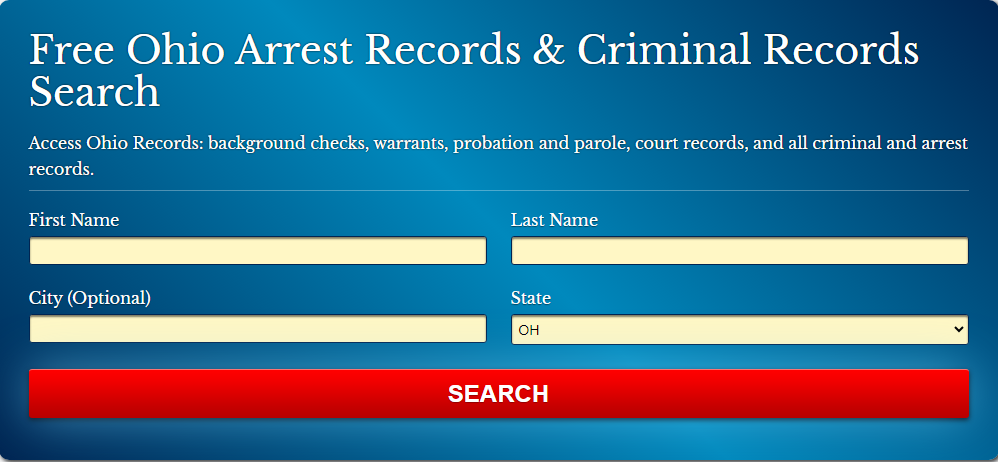
What Is Arrests.org OH?
Arrests.org OH is a public database that gathers and displays arrest-related data from law enforcement agencies across Ohio. It offers a centralized way to explore recent arrest events, booking logs, and detention updates from county jails and police departments throughout the state.
Many visitors use the site to stay informed about criminal activity, verify public information, or conduct basic background inquiries. The platform makes it easy to sort results by name, date, county, and other criteria.
What Information Can You Find on Arrests.org OH?
Arrests.org OH features details related to recent arrests reported in various Ohio regions. You might see:
- Full name, age, and address of the individual
- Date and location of arrest
- List of charges and legal classifications
- Mugshots (when released by law enforcement)
- Name of the arresting agency
- Bail or bond amounts, if applicable
- Court schedules and case progress
- Current custody or release status
Please note: Juvenile arrests and sealed legal records are not displayed, in compliance with Ohio law.
Where Does the Data on Arrests.org OH Come From?
The information shown on Arrests.org OH is sourced directly from official law enforcement agencies throughout Ohio, including:
- Ohio State Highway Patrol
- County sheriff’s departments (e.g., Franklin, Cuyahoga, Hamilton, Montgomery)
- Municipal police departments (e.g., Columbus PD, Cleveland PD, Cincinnati PD)
Records are collected based on Ohio’s open records rules and exclude any content that is restricted by statute or court order.
How to Search Arrest Records in Ohio
Arrests.org OH allows public record searches without requiring users to create an account. Creating an account, however, may offer enhanced search filters.
Steps to Start a Basic Search:
- Go to the Arrests.org OH homepage
- Type in the person’s name in the search box
- Narrow your results by county or city if desired
- Click search to view entries
- Click on a result for complete details
Advanced Search Filters Include:
- Arrest date or a custom date range
- Specific offense types (e.g., DUI, theft, assault)
- Region or jurisdiction (county/city)
- Gender or age filters
These tools make it easier to focus your search and get more accurate results.
Why Consider Using Arrests.org OH?
Arrests.org OH brings together public arrest records from multiple Ohio jurisdictions into a single place. This saves time compared to visiting each law enforcement website separately.
It’s especially helpful for community members monitoring safety updates, conducting record checks, or keeping tabs on legal actions across Ohio.
Who Can Access Ohio Arrest Records?
In Ohio, adult arrest records are considered public under state law and may be accessed by anyone interested, including employers, journalists, or private individuals. However, any records that are sealed, expunged, or involve minors remain inaccessible to the public.
Arrests.org OH only displays legally shareable data made available by Ohio agencies under public records regulations.
When Is Arrest Data on the Site Updated?
Arrest listings on Arrests.org OH are updated regularly, often within one to three days of the arrest event being processed and made public by authorities.
This helps ensure visitors have near real-time access to the latest publicly available arrest reports from agencies throughout Ohio.
Public Access to Criminal and Arrest Records
Section 149.42 under the Ohio Laws & Administrative Rules states that criminal records and arrest records are public information. These laws, known as “Sunshine Laws,” extend to various types of information, including marital status, court documents, property records, and more. Public records and open meetings laws provide Ohioans access to government meetings and records. Keep in mind that there are exceptions to this rule, such as sealed, expunged, or juvenile records.
Difference Between Criminal Records & Arrest Records
When seeking records information, it’s crucial to distinguish between a criminal record search and an Ohio arrest record. Arrest records indicate that an individual was detained by the police based on suspicion of committing a crime, but they do not prove guilt. In contrast, a criminal record offers comprehensive information, including arrest details, charges, court proceedings, case outcomes, and past charges on an individual’s criminal history.
How to Access Arrest Information for Free
If you know the county or vicinity where the arrest occurred, the quickest way to access arrest records is through the county inmate search tool or by contacting the county’s sheriff’s office.
Stay informed about Ohio’s accessible public records and make informed decisions when researching individuals.
How to Contact Inmates and Post Bail
Each jail in Ohio operates with slightly different procedures and regulations, particularly concerning visitation, which can vary before, during, and after the visit. For the most accurate and up-to-date visiting and contact information, it’s highly recommended to directly contact the specific jail facility.
To facilitate your search and prepare for visitation, consider these steps:
- Visit the Jail’s Website: The most effective way to learn about contacting an inmate and preparing for visitation is to visit the jail’s official website.
- Utilize County Inmate Links: Refer to the county inmate links provided in the chart below, which can guide you to the respective sheriff’s office websites.
- Review Visitation Policies: Typically, visitation policies are prominently displayed on the sheriff’s office website’s homepage. If not, use the search bar to look for “visitation” information.
- Contact the Sheriff’s Office: In case of any issues or additional questions, don’t hesitate to contact the sheriff’s office or the county jail using the provided phone number in the chart.
- Understanding Bail Procedures: When inquiring about bailing someone out, it’s crucial to note that each Ohio jail may have a slightly different process. Once again, reaching out to the jail or sheriff’s office either by phone or through the county jail’s website is the best way to obtain specific bail information.
- Consider a Bail Bondsman: If you encounter any challenges or complexities while navigating the bail process, a bail bondsman can be a valuable resource. They can expedite and simplify the process of posting bail.
Accessing Criminal Records in Ohio
To obtain and view criminal records in Ohio, the local county courthouse is the primary source. These records are often stored at the county level, making it essential to start your search there.
While online criminal history reports directly through the Bureau of Criminal Investigation (BCI) are not publicly available, you can request your criminal record report from the BCI by submitting the necessary forms.
Accessing Criminal Records Through the Ohio Attorney General
If you need to access criminal records maintained by the Ohio Bureau of Criminal Investigation (BCI), you’ll have to go through the Ohio Attorney General’s office, as these records are not publicly accessible online. This process is typically used when individuals want to obtain their criminal records to verify accuracy and completeness.
To request criminal records from the BCI through the Ohio Attorney General, you’ll need to provide specific information and follow certain steps:
- Individual’s Information: You must provide the complete name, address, and any other identifying characteristics of the individual whose records you’re seeking.
- Fingerprints: A complete set of fingerprints is required as part of the request.
- Consent: You’ll need signed consent from the individual whose records are being obtained.
- Payment: Please note that this service is not free. You will need to include a payment of $22, which can be made by business check, money order, or electronic payment.
- Fingerprint Submission: For your convenience, you can submit fingerprints at any of the four different BCI locations.
Obtaining criminal records through the Ohio Attorney General’s office is particularly useful when you need to review your records for personal verification or legal purposes.
Please be aware that accessing certain records may require adherence to state and federal laws, and some information may be restricted or protected by privacy regulations. Always ensure that your search for records complies with legal requirements.
This method provides a reliable and official way to obtain criminal records directly from the Ohio Bureau of Criminal Investigation.

Obtaining Copies of Criminal Records in Ohio (OH)
While Ohio doesn’t offer extensive statewide online searches for criminal records, there are alternative methods to request and access such records. One effective approach is to request records through the Ohio State Patrol, as these criminal records are considered public under the Ohio Revised Code 149.43[^3^]. You can request various types of records, including body-worn camera recordings, transcripts of 911 calls, criminal investigation case information, and more.
Here’s a step-by-step guide on how to search for records through the Ohio State Patrol:
- Navigate to the Public Records Center: You can access the Public Records Center through the Ohio Department of Public Safety website.
- Account Creation (Optional): While creating an account is optional, it offers some benefits, such as the ability to track your record requests. You can create a free account if you wish to track your request. However, if you choose not to create an account, be sure to remember the reference number provided for updates and additional information requests.
Fill Out Required Forms: Specify the records you’re requesting by filling out the required forms. Provide the following information:
- The type of record(s) you’re requesting.
- A clear description of the record(s) you’re seeking.
- Your preferred method to obtain the records (electronic, inspect on-site, fax, pick-up, regular mail).
Additional Documents: You have the option to attach any relevant documents or images that may assist with your Ohio criminal records request.
By following these steps, you can initiate a request for the specific records you need from the Ohio State Patrol. It’s important to remember that certain records may have specific access requirements, so always ensure that your request complies with relevant laws and regulations.
Ohio’s commitment to transparency and open access to public records makes it possible for individuals to access a wide range of records, including those related to criminal activities.
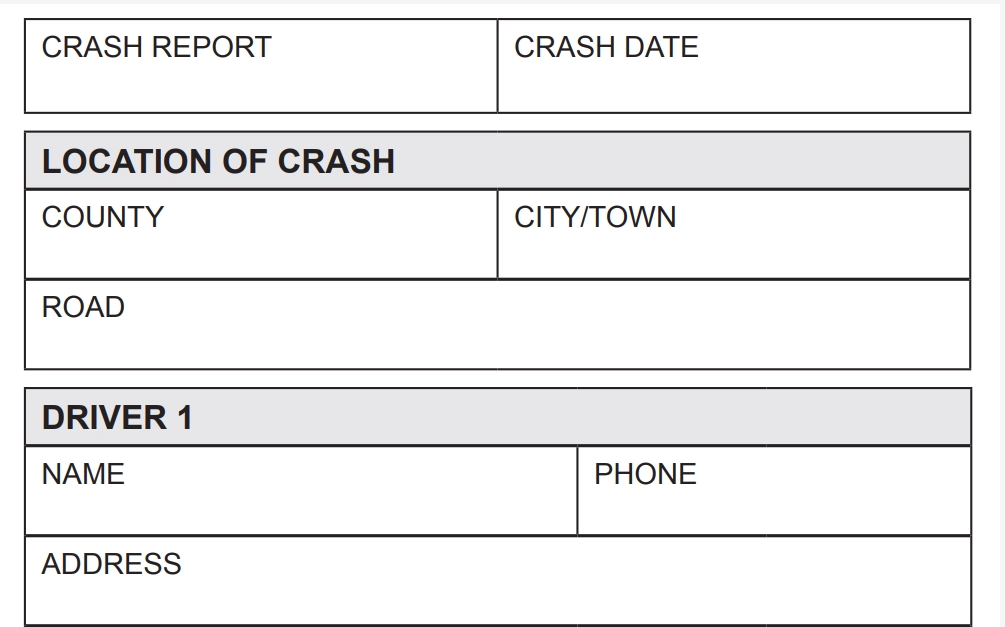
In addition to the methods mentioned earlier, there are alternative ways to obtain criminal records in Ohio. You can consider contacting the Clerk of Court or the county’s sheriff’s department for further assistance. To do so, simply reach out to the specific county you’re interested in by using the contact information provided in the tables above.
Determining Probation or Parole Status in Ohio
If you need information regarding an individual’s probation or parole status in Ohio, you can utilize the Ohio Department of Rehabilitation and Correction’s offender search feature. This database allows you to access information about individuals who are currently serving sentences in Ohio prisons and are under department supervision. It also provides information about individuals whose sentences have been reduced through judicial release[^4^].
To offer some insight into the number of individuals on probation and parole, the following image provides statistics on the combined total of probationers and parolees in Ohio, categorized by ethnicity. These figures are also compared to the number of individuals under community supervision (including probation and parole) in various states across the United States.
Ohio’s commitment to transparency and accessibility of criminal records ensures that individuals have multiple avenues to obtain the information they need, whether it’s related to criminal history or probation and parole status.
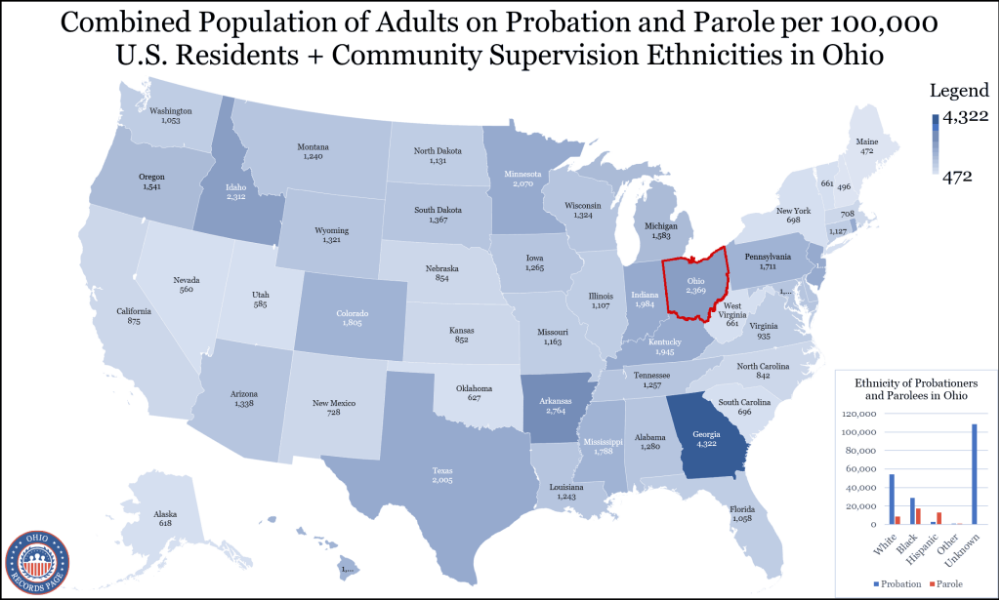
Understanding the Distinction Between Probation and Parole
When seeking information related to probation or parole in Ohio, it’s crucial to comprehend the significant differences between these two forms of supervision. These distinctions are based on the nature of the offense and the individual’s criminal history:
- Parole: Parole typically applies to individuals who have been released from prison before serving their full sentence. It is often granted to individuals convicted of more serious offenses. Those on parole are closely monitored by the Adult Parole Authority (APA).
- Probation: Probation, on the other hand, is typically assigned to individuals who have served minimal or no jail time and have been convicted of minor offenses or misdemeanors. It allows individuals to remain in the community under certain conditions while being supervised by probation officers.
Identifying Probation and Parole Status in Ohio
To determine an individual’s probation or parole status in Ohio, you can utilize the Ohio Department of Rehabilitation and Correction’s offender search feature. In this database, individuals under parole supervision are listed as being under “Adult Parole Authority (APA) supervision,” while those under probation are identified as “RELEASED- judicial release.” Below are examples of how these statuses are displayed:
- Adult Parole Authority (APA) supervision: This status indicates that the individual is on parole and is being supervised by the APA.
- RELEASED- judicial release: Individuals with this status are on probation and have been released through judicial release.
Understanding these designations will help you accurately identify an individual’s status within the Ohio criminal justice system. Whether you are seeking information about parolees or probationers, utilizing the Ohio Department of Rehabilitation and Correction’s offender search can provide you with valuable insights.
Please note that the distinction between parole and probation varies from state to state, and the specific criteria and regulations may differ accordingly. Always ensure you are familiar with the legal definitions and procedures relevant to your jurisdiction.
Ohio Department of Rehabilitation and Correction Offender Search
This tool allows users to locate individuals currently incarcerated in Ohio state prisons. It provides access to offender profiles, including sentencing information and facility location.
Ohio Revised Code 149.43
This section outlines Ohio’s public records law, defining what records are accessible and under what circumstances. It plays a central role in ensuring government transparency.
Ohio Sunshine Laws Manual
Published annually, this manual helps citizens and public officials understand Ohio’s public records and open meetings laws. It offers practical guidance on accessing government information.
Ohio Attorney General
The Ohio Attorney General’s office oversees legal compliance for public records and open meetings. It also provides educational materials and handles certain public records disputes.
Ohio State Patrol Public Records Center
This portal gives access to crash reports, incident logs, and other law enforcement documents maintained by the Ohio State Highway Patrol. Users can submit requests and track their status.


Accessing Additional Information About Parole and Release
When researching an individual’s parole or release status in Ohio, there are valuable resources available that provide in-depth information:
- Detailed Profile Information: Clicking on an individual’s profile in the Ohio Department of Rehabilitation and Correction’s offender search database will reveal more comprehensive details. This includes crucial information such as the expected release date and eligibility for parole. This additional information can provide insight into an individual’s future status within the criminal justice system.
- Parole Violators at Large: The Ohio Department of Rehabilitation and Correction maintains a list of parole violators who are currently at large. This information is directly accessible on their website, allowing individuals to stay informed about individuals who have violated the terms of their parole and are sought by authorities.
Searching for Federally Charged Inmates
If you are specifically interested in federally charged inmates, it is advisable to consult the Federal Bureau of Prisons’ website. While this resource primarily provides historical information about individuals who have served time in federal prisons, it may offer insights into recent releases. While it may not explicitly indicate parole status, recent release information can suggest that an individual is now under parole supervision.
Please note that the distinction between federal and state charges can significantly impact an individual’s incarceration and parole status. Therefore, understanding the nature of an individual’s charges and their legal history is essential when conducting a thorough search for parole or release information.
Federal Bureau of Prisons
These resources can assist you in obtaining comprehensive information about parole, release, and the legal status of individuals within the criminal justice system. It is essential to stay informed and use these tools responsibly when seeking information about parolees and recently released individuals.
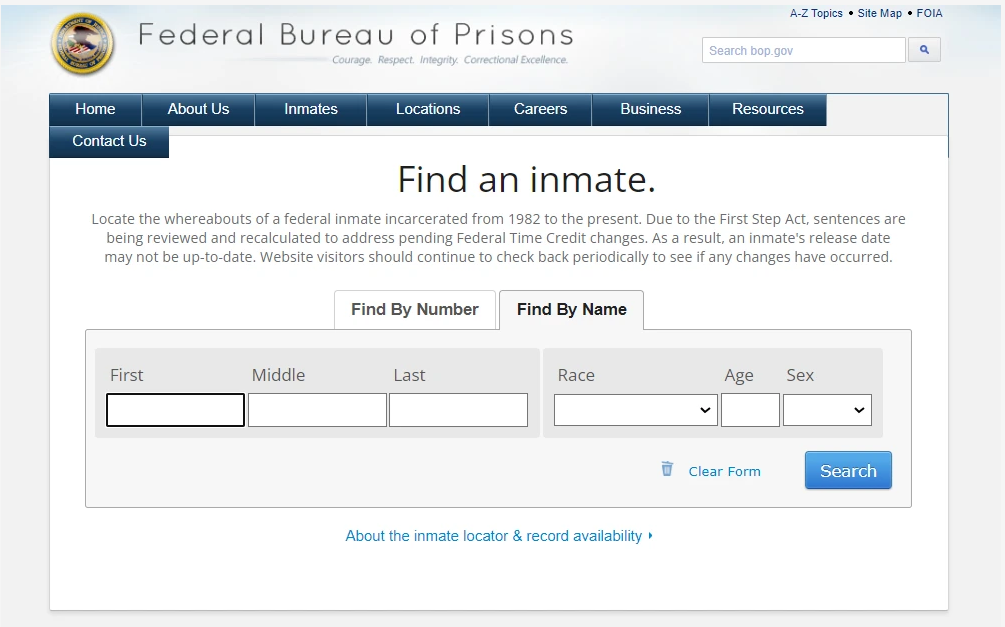
Accessing Information Through VineLink
When searching for probation information, VineLink can be used as a last resort. VineLink aggregates data from various agencies, including probation and parole offices. However, it’s advisable to explore the previously mentioned resources first, as VineLink may experience delays in retrieving data compared to direct agency sources.
In case you encounter difficulties or have additional inquiries, consider reaching out to county courthouses or contacting probation and parole offices directly. These agencies can provide valuable assistance and guidance.
Sealing or Expunging Criminal Records in Ohio
Ohio law provides provisions for sealing or expunging criminal records under Ohio Revised Code section 2953.31. Recent legislative changes in April 2023 have expanded eligibility criteria, allowing more individuals to seal their Ohio criminal records. These changes permit the sealing of up to five non-violent, non-sexual felony convictions and an unlimited number of non-violent and non-sexual misdemeanor convictions.
However, it’s important to note that certain records, such as first or second-degree felonies, remain ineligible for sealing.
Ohio does not have an automatic expungement or sealing policy. Individuals seeking record sealing must apply. The waiting period for the application varies depending on the severity of the conviction. Misdemeanor convictions require a one-year waiting period after completing the sentence, while felony convictions necessitate a waiting period of three to five years, depending on the offense’s seriousness.
Applications typically incur a $50 fee and should be filed through the County Court of Common Pleas, with completed applications sent to the County Clerk of Courts. County-specific policies and submission instructions may apply, so it’s essential to research the requirements of the specific county.
While less common, criminal records can also be expunged in Ohio, with detailed conditions outlined in Section 2953.32 of the Ohio code. Seeking legal counsel from an attorney or lawyer is generally recommended to navigate this process effectively.
Identifying an Individual’s Prison Location
To determine if someone is incarcerated in an Ohio state prison, the Ohio Department of Rehabilitation and Correction offers a free inmate search platform. This search can be conducted using various criteria, including the inmate’s first or last name, status (such as incarcerated, APA supervision, or violator at large), or the inmate’s offender number, which typically begins with a prefix ‘A,’ ‘R,’ or ‘W.’
Search results provide comprehensive information, including the inmate’s name, offender number, status, and additional details. Clicking on an inmate’s name reveals further information, including their mugshot, physical characteristics, charges, expected release date, and parole eligibility date.
This resource enables individuals to verify an individual’s current incarceration status within the Ohio state prison system.
Determining Federal Incarceration Status
For individuals seeking information about someone’s federal incarceration status, the Federal Bureau of Prisons website offers historical data on individuals who have served time in federal prisons. While it may not explicitly indicate parole status, this resource can provide insights into recent releases, which may suggest parole supervision. It’s important to be aware that this resource primarily focuses on federal incarceration.
When conducting searches related to an individual’s legal status and incarceration, it’s essential to consider both state and federal jurisdictions, as they may operate independently of each other.
Federal Bureau of Prisons
By utilizing these resources and understanding the nuances of Ohio’s criminal record sealing and expungement laws, individuals can access valuable information about an individual’s legal history, incarceration status, and the processes involved in modifying their criminal records. Additionally, seeking legal counsel can help navigate complex legal procedures effectively.

State-Run Facilities in Ohio
Ohio is home to twenty-eight state-run correctional facilities, organized into North, South, and Specialty regions. The Ohio Department of Rehabilitation and Correction (ODRC) oversees these facilities, which house inmates from various backgrounds and serve distinct purposes. Understanding the locations and functions of these facilities can provide valuable insights into Ohio’s correctional system.
Historical Federal Inmate Information
Individuals seeking historical information on federally charged inmates can turn to the Federal Bureau of Prisons (BOP) website. By providing either the first and last names or the inmate’s unique identification number, individuals can access data related to federal incarceration. Although this resource may not explicitly specify parole status, it can offer valuable insights into recent releases, which might indicate parole supervision. It’s crucial to note that this resource primarily focuses on federal inmates.
Conducting a Warrant Search in Ohio
While Ohio lacks a centralized statewide database for warrant searches, there are effective ways to determine whether an individual has an active warrant for their arrest. The process typically involves contacting the specific county where the warrant was issued or using the county’s online warrant search feature, where available. For instance, Montgomery County in Ohio offers an online warrant search tool for public use.
Additionally, the Ohio Department of Rehabilitation and Correction maintains a comprehensive list of individuals categorized as “Violators at Large.” These individuals are wanted by the Adult Parole Authority due to violations of their supervision conditions. It’s essential to exercise caution when dealing with individuals classified as “violators at large,” as they should be considered potentially dangerous and possibly armed.
By leveraging these resources and understanding the limitations of Ohio’s warrant search capabilities, individuals can access information regarding active warrants and take appropriate actions when necessary.
Montgomery County Warrant Search
In summary, navigating Ohio’s correctional facilities, researching historical federal inmate data, and conducting effective warrant searches are essential aspects of accessing comprehensive legal information. Understanding the nuances of these processes empowers individuals to make informed decisions and access relevant legal records in Ohio.
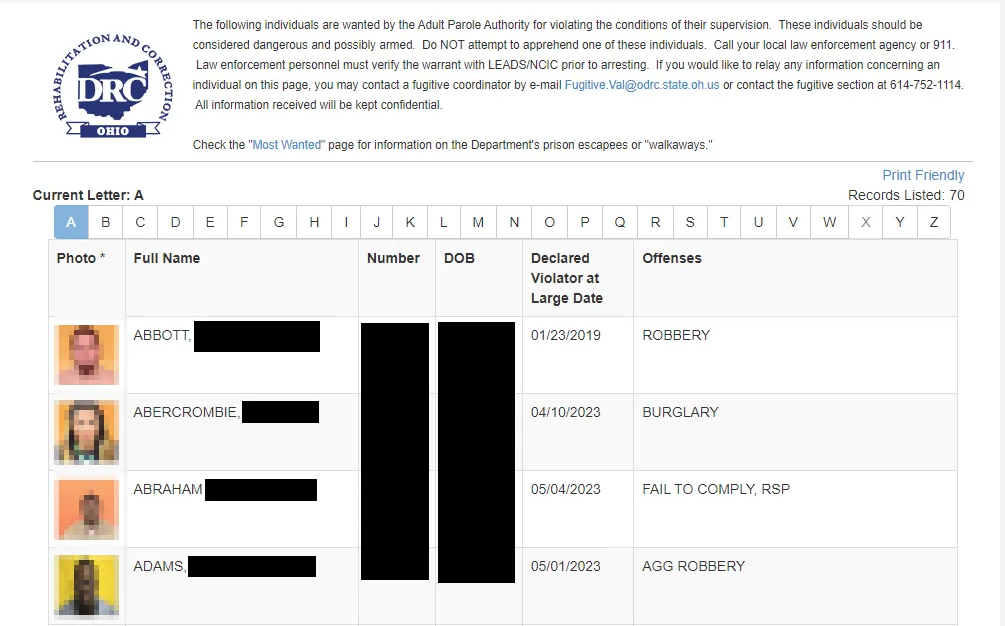
County-Specific Warrant Searches in Ohio
In Ohio, individuals can initiate a warrant search by entering “[County Name] warrant search” into a search engine and accessing the official county website corresponding to their desired region. Many counties offer an online warrant search tool accessible through their website. However, in cases where online search functionality is not available, individuals can refer to the contact page to obtain the phone number for the county sheriff’s office. The county sheriff’s office can provide guidance and assistance regarding active warrants in its jurisdiction. The comprehensive table earlier in this guide contains contact information for various county sheriff’s offices in Ohio.
Federal Warrants and the U.S. Marshals
Federal warrants, distinct from state or county warrants, are issued by the United States Marshals Service (USMS). These federal warrants are managed within the Warrant Information System (WIN). It’s important to note that federal warrants are not accessible to the general public. Access to federal warrant information is restricted, and only authorized law enforcement agencies and personnel can search and retrieve federal warrant records. As such, individuals seeking information related to federal warrants must explore alternative avenues.
Background Checks in Ohio: Understanding the Process
The process of obtaining a background check in Ohio can be initiated by directly contacting the Ohio Attorney General’s Bureau of Criminal Investigation (BCI) through designated Web Check locations. These locations facilitate the submission of background check requests and the collection of essential information. To initiate a background check, individuals should follow these steps:
- Locate a nearby Web Check location by visiting the official Ohio Attorney General’s website or contacting their office directly. A list of Web Check locations is typically available for reference.
- Visit the chosen Web Check location in person. Be prepared to provide personal information, including your complete name and address, as well as any other identifying characteristics as required.
- Submit a complete set of fingerprints as part of the background check process.
- Ensure that you have signed consent from the individual whose criminal records are being requested.
- Be prepared to cover the associated fees, typically amounting to $22. Payment options may include business checks, money orders, or electronic payments.
- Follow the specific instructions provided by the chosen Web Check location to complete the background check request.
It’s important to note that background check services offered by the BCI are primarily intended for individuals seeking their own criminal records to verify accuracy and completeness. For comprehensive background checks on others, individuals may need to explore additional resources or enlist the services of professional background check providers.
Understanding the background check process in Ohio empowers individuals to access pertinent information while adhering to established guidelines and requirements.
- Ohio Attorney General’s Office – Background Check Information
- Ohio Attorney General’s Office – Web Check Locations
- Ohio Attorney General’s Office – Background Check FAQs
In summary, conducting county-specific warrant searches, understanding the limitations of accessing federal warrants, and navigating the background check process in Ohio are essential components of obtaining comprehensive legal information in the state. By following the outlined procedures and leveraging available resources, individuals can access relevant records and make informed decisions in various legal and personal contexts.
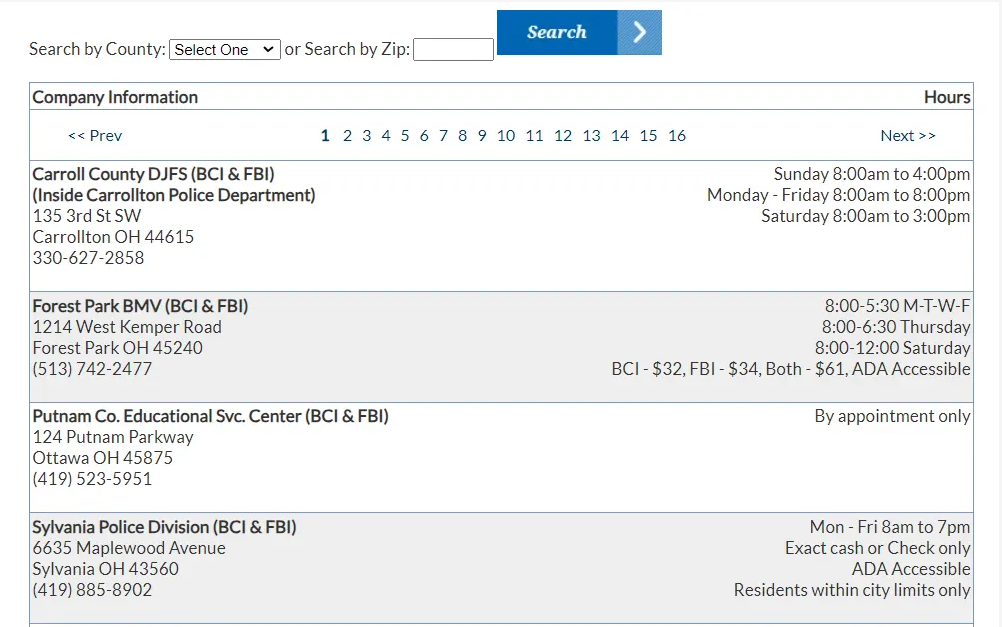
Background checks serve a variety of personal and professional purposes, offering valuable insights into an individual’s history and background. These checks are conducted by both individuals and organizations for diverse reasons, ranging from personal safety and employment screening to firearm purchases and adoption applications. It’s important to distinguish between personal and professional background checks, each subject to specific laws and regulations.
Personal Background Checks
Personal background checks are often initiated without the prior consent of the individual being investigated. They are commonly used for personal reasons, including:
- Personal Safety: Individuals may conduct background checks to ensure their safety and the safety of their loved ones when interacting with others in various settings.
- Learning About Someone: Personal background checks allow individuals to gather information about others, such as acquaintances, neighbors, or potential romantic partners.
- Residency: In some cases, landlords or property owners may perform background checks on prospective tenants to assess their suitability for rental properties.
Personal background checks can uncover a range of information, including criminal records, personal details, employment history, addresses, and more. However, it’s crucial to emphasize that the information obtained through personal background checks should not be used for illegal or harmful purposes, such as harassment, stalking, or hate crimes.
To conduct personal background checks, individuals can explore various avenues, including court criminal record searches, state police searches, and third-party people finder services that cover multiple counties, cities, and states simultaneously.
Professional Background Checks
Professional background checks are typically conducted by employers, organizations, or agencies for specific purposes such as employment, residency verification, and adoptions. These checks require the consent of the individual being investigated and must adhere to federal and state laws designed to protect individuals from discrimination.
Professional background checks are comprehensive and encompass various aspects of an individual’s history, including:
- Criminal Records: These checks examine criminal history, including Ohio arrest records and convictions.
- Education: Verification of educational qualifications and degrees.
- Credit Histories: Assessing an individual’s financial history and creditworthiness.
- Social Media: Reviewing an individual’s online presence on social media platforms.
Federal and state laws, including the Equal Employment Opportunity Commission (EEOC) and the Fair Credit Reporting Act (FCRA), govern professional background checks. The FCRA specifies that background check reports can only be provided to individuals with a legitimate purpose.
Professional background checks are categorized into two levels:
- Level 1 Checks: These checks are conducted by name or name and Social Security number, primarily focusing on local records at the state or county level.
- Level 2 Checks: Level 2 checks are more extensive and inclusive, examining national records. They require fingerprint submission and are processed by the Federal Bureau of Investigation (FBI).
Level 2 background checks yield significantly more information, including previous addresses, employers, marital status, credit history, educational and professional certifications, misdemeanors, felonies, pending criminal cases, civil judgments, arrest records, sex crimes, and prison or jail records.
Level 2 background checks are commonly used for employment roles that involve at-risk populations, such as the elderly, children, healthcare professionals, and certain executive positions.
Checking for Nearby Sexual Offenders in Ohio
Ohio provides a statewide online directory of registered sex offenders, offering information about their home addresses, work addresses, and vehicle details. To search the registry, individuals can use various criteria:
- In the Area: Allows users to view offenders within a specified radius of a given address, such as a home, business, or school.
- Name: Enables the search for a specific offender by first or last name.
- City: Provides results of offenders within a particular city.
- Non-Compliant: Displays offenders who have not updated their information as required.
- Internet Names/Email: Offers the option to search by email address or any internet name used.
- Phone Number: Allows searching for an offender by their phone number.
Accessing this registry can assist individuals in staying informed about registered sex offenders in their vicinity, enhancing personal safety and community awareness.
- Ohio Attorney General’s Office – Background Check Information
- Ohio Attorney General’s Office – Web Check Locations
- Ohio Attorney General’s Office – Background Check FAQs
- Ohio Attorney General’s Office – Sex Offender Search
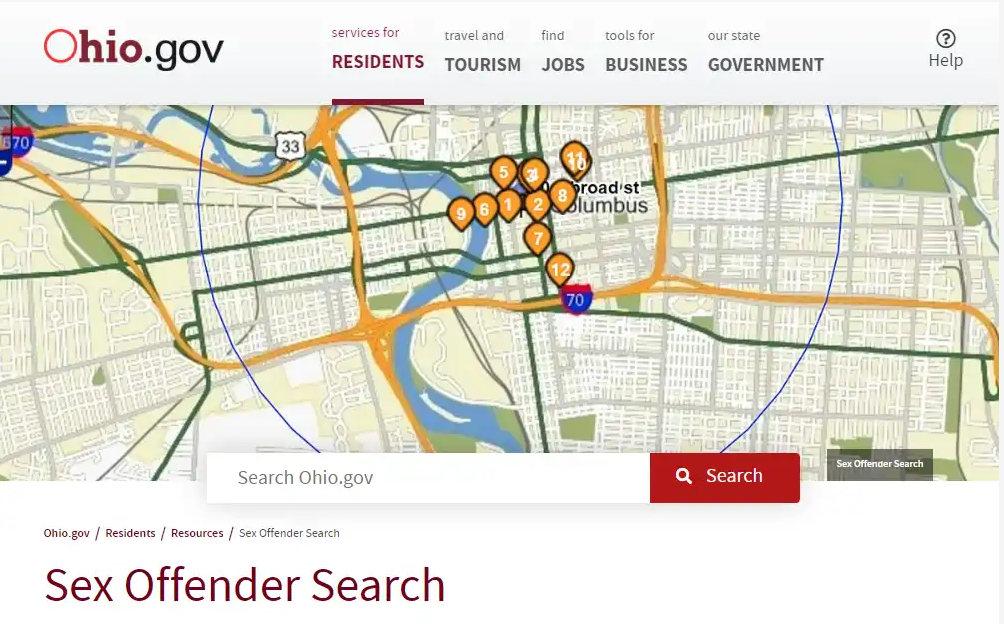
Ohio Sex Offender Registry
The Ohio Attorney General’s Office maintains a comprehensive Ohio Sex Offender Registry, providing the public with access to vital information about registered sex offenders in the state. This resource serves as a valuable tool for individuals and communities to enhance safety and awareness.
Search All Published Sex Offenders in Ohio
One notable feature of the Ohio Sex Offender Registry is the ability to search for all published sex offenders in the state in a single search result. This convenient option allows users to access a comprehensive list of registered sex offenders, streamlining the process of staying informed about potential risks in their vicinity.
Detailed Offender Information
The Ohio Sex Offender Registry provides detailed information about each registered sex offender, including:
- Mugshot Database: Users can view photographs of registered sex offenders, aiding in visual identification.
- Demographics: Information about the offender’s demographics, such as age, gender, and physical characteristics, is available to help individuals recognize potential threats.
- Conviction Details: The registry includes specifics about the offender’s criminal convictions, providing insights into their past offenses.
- Address: Registered sex offenders’ current addresses are listed, allowing users to be aware of their proximity to these individuals.
Tracking Offenders
For added convenience and safety, the Ohio Sex Offender Registry offers the option to register to track a specific offender using an email address. This feature enables individuals to receive notifications and updates regarding any changes in the offender’s status or location, empowering them to take necessary precautions and stay vigilant.
Accessing the Ohio Sex Offender Registry provides an effective means for individuals and communities to promote safety, protect vulnerable populations, and make informed decisions about their surroundings.
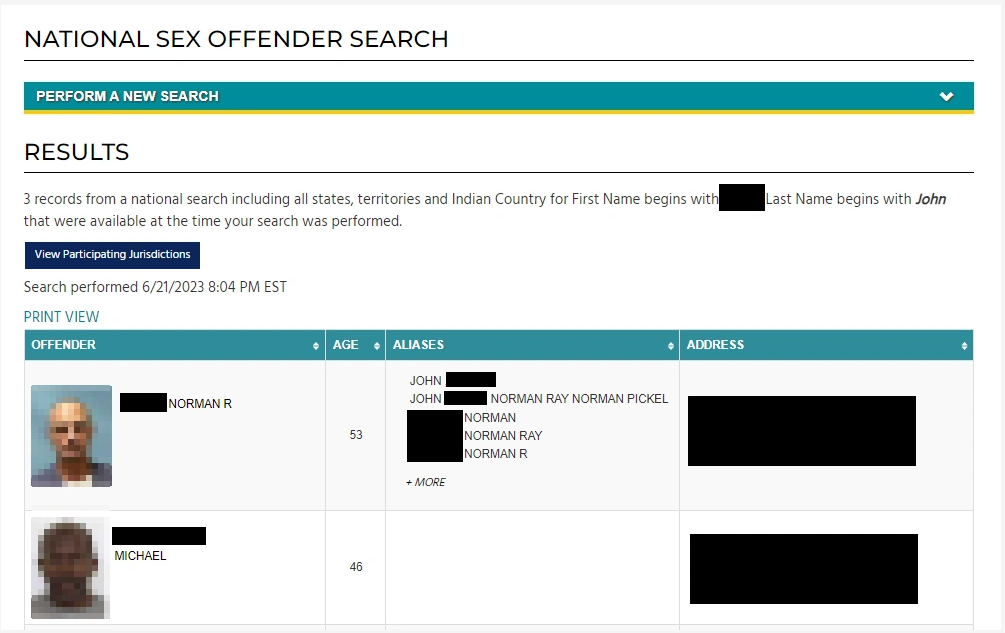
Accessing the National Sex Offender Registry
In addition to the Ohio-specific resources, individuals seeking a broader perspective can utilize the National Sex Offender public website provided by the United States Department of Justice. This national database allows users to search for registered sex offenders across the entire United States, offering a comprehensive view of sex offender information beyond Ohio’s borders.
Exploring the Habitual Operating a Motor Vehicle While Intoxicated (OMVI) Registry
Ohio introduced the Habitual Operating a Motor Vehicle While Intoxicated (OMVI) Offender Registry in 2008, by Ohio Revised Code 5502.10. This registry serves as a public records repository containing information about individuals who have been convicted at least five times of operating a motor vehicle while under the influence of alcohol or drugs. It’s important to note that, in many other states, charges for operating a motor vehicle while intoxicated are referred to as DUIs (Driving Under the Influence) or DWIs (Driving While Intoxicated).
Registry Inclusions and Exclusions
The Habitual Offender Registry includes convictions within the past 20 years and those of individuals who are deceased. It is worth mentioning that even juvenile offenses are included in this registry, reflecting Ohio’s commitment to addressing habitual intoxicated driving.
Regular Updates
To maintain the accuracy and reliability of the Habitual Offender Registry, it undergoes weekly updates based on information provided by Ohio courts to the Ohio Department of Public Safety. This ensures that the public has access to the most current and relevant data concerning habitual intoxicated driving offenders.
For inquiries or further information about this database, individuals can reach out to the Ohio Traffic Safety Office at OTSO@dps.ohio.gov. This resource not only serves as a tool for public awareness but also as a means to promote safer roadways by identifying habitual intoxicated driving offenders.

Navigating the Habitual OVI/OMVI Offenders Registry
To access the Habitual OVI/OMVI Offenders Registry, individuals have the option to search for offenders by name or explore an entire county’s records. The search results will provide detailed information about the offender, including their name, address, date of birth, and case number. Additionally, the results will outline the nature of their offenses, shedding light on their history of intoxicated driving.
Understanding Ohio Laws on Criminal and Arrest Records
Ohio operates under the Ohio Sunshine Laws, which ensure that public records, including criminal and arrest records, are openly accessible to the public. However, some exceptions exist, such as sealed, expunged records or juvenile records, which are not disclosed.
In 2015, Ohio implemented Policy HR-29, which introduced protective measures for job applicants during the application process. This policy stipulates that applicants are not required to disclose their criminal records until the initial interview phase. It also mandates that all final candidates for positions in Ohio must undergo a criminal background check. Specific agencies retain the authority to establish their policies related to background checks.
Balancing Personal and Professional Background Checks
For personal criminal record background checks and searches, it is acceptable to conduct these without prior consent from the individuals in question. However, when it comes to professional background checks, such as those conducted for property management, licensing, or employment purposes, strict adherence to state, local, and federal laws is required. This includes compliance with the Fair Credit Reporting Act (FCRA) and adherence to guidelines established by the Equal Employment Opportunity Commission (EEOC).
Equal Employment Opportunity Commission (EEOC) Guidelines
The EEOC plays a vital role in safeguarding individuals against discrimination. It ensures that all individuals are afforded equal opportunities and are held to the same standards, regardless of factors like race, age, or disability.
Fair Credit Reporting Act (FCRA) Compliance
The FCRA provides additional protection for individuals when background checks are conducted on them. Key provisions include obtaining the applicant’s written permission for the background check, disclosing what information was used in making employment decisions, and allowing the applicant to receive a copy of the consumer report if they so desire.
Whether individuals are seeking Ohio arrest records or are interested in a more comprehensive view of Ohio criminal records, this guide serves as a valuable resource, outlining the steps to access public criminal records. It empowers citizens to gain insights into an individual’s past, fostering informed decision-making and awareness of legal considerations.
FAQ’s
If you have questions about accessing criminal records in Ohio, the following frequently asked questions can help guide you through the process. Whether you’re requesting your records or looking into someone else’s with consent, it’s important to understand the proper procedures and legal guidelines.
How can I access my criminal record in Ohio?
To obtain a copy of your criminal record in Ohio, you can apply directly to the Ohio Attorney General’s Bureau of Criminal Investigation (BCI). You’ll need to provide your complete name, address, and any other identifying information, along with a set of fingerprints and signed consent. There is a fee of $22 for this service. You can submit your request and payment through a Web Check location or mail it to the BCI. Keep in mind that criminal records for background checks on others may have different procedures.
Can I access someone else’s criminal record in Ohio?
Yes, you can access someone else’s criminal record in Ohio, but you’ll need their permission to do so. Personal background checks on individuals without their consent are not allowed for purposes like employment or rental applications. For professional background checks, such as those used for employment screening, consent from the individual is mandatory. Accessing someone’s criminal record without proper consent may violate state and federal laws.
How long does it take to get criminal records through the Ohio Attorney General’s office?
The processing time for obtaining criminal records through the Ohio Attorney General’s office can vary. It depends on factors such as the volume of requests and the accuracy of the information provided. In some cases, it may take several weeks to receive the requested records. If you have specific timing requirements, it’s advisable to contact the Ohio Attorney General’s office directly for more information.
Can I access sealed or expunged records in Ohio?
Sealed or expunged records in Ohio are typically not accessible to the general public. These records are confidential and are not included in standard background checks. Sealing or expunging a record means that it is hidden from most background checks, but certain government agencies and law enforcement entities may still have access to it.
Are there any restrictions on using Ohio criminal records for employment purposes?
Yes, there are restrictions and guidelines for using Ohio criminal records for employment purposes. Ohio’s Policy HR-29 protects job applicants by allowing them not to disclose their criminal records until the initial interview phase. It also mandates that all final candidates for positions in Ohio must undergo a criminal background check. Specific agencies may have their own policies regarding background checks, and all professional background checks must adhere to federal and state laws, including the Fair Credit Reporting Act (FCRA) and Equal Employment Opportunity Commission (EEOC) guidelines. These laws protect individuals against discrimination and regulate how background checks are conducted for employment decisions.
